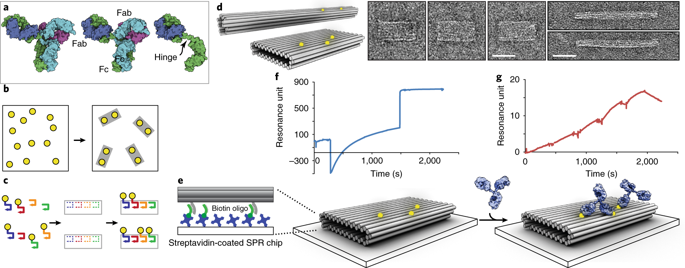Nature Nanotechnology ( IF 38.1 ) Pub Date : 2019-01-14 , DOI: 10.1038/s41565-018-0336-3 Alan Shaw , Ian T. Hoffecker , Ioanna Smyrlaki , Joao Rosa , Algirdas Grevys , Diane Bratlie , Inger Sandlie , Terje Einar Michaelsen , Jan Terje Andersen , Björn Högberg

|
Although repetitive patterns of antigens are crucial for certain immune responses, an understanding of how antibodies bind and dynamically interact with various spatial arrangements of molecules is lacking. Hence, we introduced a new method in which molecularly precise nanoscale patterns of antigens are displayed using DNA origami and immobilized in a surface plasmon resonance set-up. Using antibodies with identical antigen-binding domains, we found that all the subclasses and isotypes studied bind bivalently to two antigens separated at distances that range from 3 to 17 nm. The binding affinities of these antibodies change with the antigen distances, with a distinct preference for antigens separated by approximately 16 nm, and considerable differences in spatial tolerance exist between IgM and IgG and between low- and high-affinity antibodies.
中文翻译:

与纳米模式抗原的结合主要取决于抗体的空间耐受性
尽管抗原的重复模式对于某些免疫反应至关重要,但仍缺乏对抗体如何结合以及分子的各种空间排列动态相互作用的了解。因此,我们引入了一种新方法,其中使用DNA折纸显示抗原的分子精确纳米级图案,并将其固定在表面等离振子共振设置中。使用具有相同抗原结合结构域的抗体,我们发现所研究的所有亚类和同种型均以双价结合两种以3至17 nm的距离分离的抗原。这些抗体的结合亲和力随抗原距离的变化而变化,明显偏爱间隔约16 nm的抗原,IgM和IgG之间以及低亲和力和高亲和力抗体之间存在很大的空间耐受性差异。











































 京公网安备 11010802027423号
京公网安备 11010802027423号